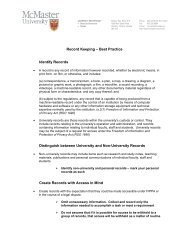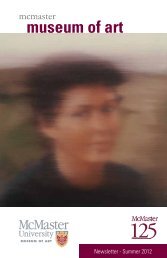Craig L. Blomberg and Mariam J. Kamell, James
Craig L. Blomberg and Mariam J. Kamell, James
Craig L. Blomberg and Mariam J. Kamell, James
Create successful ePaper yourself
Turn your PDF publications into a flip-book with our unique Google optimized e-Paper software.
[MJTM 10 (2008–2009) R9–R12]<br />
BOOK REVIEW<br />
<strong>Craig</strong> L. <strong>Blomberg</strong> <strong>and</strong> <strong>Mariam</strong> J. <strong>Kamell</strong>. <strong>James</strong>. Zondervan<br />
Exegetical Commentary on the New Testament. Gr<strong>and</strong> Rapids:<br />
Zondervan, 2008. 280 pp. Hdbk. US$24.99.<br />
<strong>James</strong> by <strong>Craig</strong> L. <strong>Blomberg</strong> <strong>and</strong> <strong>Mariam</strong> J. <strong>Kamell</strong> offers a<br />
useful scholarly resource to teachers <strong>and</strong> pastors. The emphasis<br />
of the commentary is on applying <strong>James</strong>’ teaching on wealth <strong>and</strong><br />
poverty to contemporary church life. The themes of trial <strong>and</strong><br />
temptation along with wisdom <strong>and</strong> speech are also noted by the<br />
authors. The simple layout of the text helps mark out primary<br />
<strong>and</strong> supportive material in the epistle. The contemporary applications<br />
are helpful, if at times overdone. Ultimately, the commentary<br />
delivers on scholarly competence <strong>and</strong> relevant application,<br />
but the brevity of the work necessitates abbreviation of<br />
several discussions along the way.<br />
The series layout organizes the text into a logical schematic.<br />
This diagram helps to show cause, conditions, manner, <strong>and</strong> temporal/spatial<br />
description among other things. Furthermore, it<br />
places the clauses into a logical framework, making apparent<br />
which are the supporting <strong>and</strong> main clauses. The diagram could<br />
be useful for sermon <strong>and</strong> lesson preparation, in that it illustrates<br />
main points for emphasis. Also, the diagram is a good refresher<br />
for the role of various grammatical features of the Greek text. It<br />
shows the implications of conjunction choice, clause structure<br />
<strong>and</strong> qualification. The main participants in the sentence (subject,<br />
predicate, complement) are placed in bold. The diagram of the<br />
text provides a means of thinking about the sentence structure<br />
<strong>and</strong> logical relations of clauses.<br />
Unfortunately, the logical schematic is unable to show several<br />
discourse <strong>and</strong> stylistic features of the text. The diagram does not<br />
make the prominent use of hook words evident (“hook words”
R10<br />
McMaster Journal of Theology <strong>and</strong> Ministry 10<br />
repeat the ending term of a sentence at the beginning of the next<br />
sentence) <strong>and</strong> only some of the hook words used in <strong>James</strong> are<br />
identified in the verse-by-verse comment. This stylistic feature<br />
of <strong>James</strong> is a key stylistic element of the epistle. Likewise<br />
features such as word order are hard to represent on the outline.<br />
While the semantic implications of Greek word order are still<br />
somewhat under debate, diagrams that move pastors <strong>and</strong> scholars<br />
away from the actual word order of the text do not help. These<br />
diagrams do, however, provide logical relations that are based on<br />
the sentence grammar.<br />
<strong>Blomberg</strong> <strong>and</strong> <strong>Kamell</strong> are able to distill three key themes<br />
from the text of <strong>James</strong>. In contrast to Martin Dibelius’s formcritical<br />
treatment, the move toward seeing the unity of the epistle<br />
is refreshing. The structure of the epistle, based on the assertion<br />
of unity, is both plausible in an academic sense <strong>and</strong> useful in a<br />
pastoral sense. <strong>Blomberg</strong> <strong>and</strong> <strong>Kamell</strong> suggest that wealth <strong>and</strong><br />
poverty, wisdom <strong>and</strong> speech, <strong>and</strong> trials <strong>and</strong> temptations compose<br />
the most prominent themes for the epistle. In terms of explaining<br />
the text, these issues consistently recur throughout. Furthermore,<br />
almost all of what occurs in the epistle can be viewed in terms of<br />
these themes. This illustrates the compositional unity of the<br />
epistle. As far as application is concerned, these issues not only<br />
explain the historical document, but reflect key issues in living<br />
the Christian life.<br />
The theme of wealth <strong>and</strong> poverty is emphasized by <strong>Blomberg</strong><br />
<strong>and</strong> <strong>Kamell</strong>. They argue for its prominence by suggesting an<br />
arching chiastic structure that places this topic at the middle of<br />
the discourse. Also, several of the other themes contain elements<br />
of poverty <strong>and</strong> wealth in their discussions. This issue remains a<br />
perennial topic in Western Christianity <strong>and</strong> <strong>James</strong>’ valuable<br />
perspective is skillfully applied in many ways.<br />
<strong>Blomberg</strong> <strong>and</strong> <strong>Kamell</strong> attempt, somewhat awkwardly, to<br />
unify the three themes in the epistle. While the commentary<br />
clearly emphasizes wealth <strong>and</strong> poverty, the final attempt to create<br />
a unifying principle for the three themes centers around the<br />
doctrine of God, specifically that God is unswerving in his judgment<br />
<strong>and</strong> mercy. As such, Christianity should hold to this same<br />
unswerving demeanor. First, the authors do not address the issue
BLOMBERG AND KAMELL <strong>James</strong> R11<br />
of unity in terms of the three major themes asserted, leaving the<br />
reader to question the value of the categories proposed for<br />
underst<strong>and</strong>ing. Furthermore, the commentary asserts that God is<br />
both giver of mercy <strong>and</strong> gifts <strong>and</strong> judge/lawgiver in <strong>James</strong>. It is<br />
odd that the key unifying principle, then, is the unity of God’s<br />
purpose. Finally, a more traditional unifying principle is that of<br />
Christian maturity <strong>and</strong> completeness. While this completeness is<br />
rooted in the attribute of God, it encompasses a doctrinal <strong>and</strong><br />
ethical program for the Christian community.<br />
<strong>Blomberg</strong> <strong>and</strong> <strong>Kamell</strong> do not always note important<br />
dissenting opinions. The series is designed to be a resource for<br />
the church leader as well as the scholar <strong>and</strong> as such has carefully<br />
maintained a style <strong>and</strong> level of discussion commensurate with<br />
this purpose. Unfortunately, this means that several more indepth<br />
discussions were not presented in the work. For instance,<br />
<strong>Blomberg</strong> <strong>and</strong> <strong>Kamell</strong> side with Davids’ structure with three unifying<br />
themes. However, Luke Timothy Johnson argues for a singularity<br />
to the structure of the epistle. In contrast, Dibelius’s<br />
form-critical approach sees the text as a redaction of several disparate<br />
units. <strong>Blomberg</strong> <strong>and</strong> <strong>Kamell</strong> spare the reader much of this<br />
discussion, a decision that has significant implications for how<br />
one underst<strong>and</strong>s the statements of the epistle.<br />
Application of the text is a paramount concern for the authors.<br />
<strong>Blomberg</strong> <strong>and</strong> <strong>Kamell</strong> see in <strong>James</strong>’ epistle a call to work against<br />
systemic inequality. This involves both an emphasis on Christian<br />
benevolence <strong>and</strong> a reining-in of the drive to acquire wealth. Furthermore,<br />
they advocate a political perspective that must necessarily<br />
reject libertarianism in favor of a liberation theology perspective,<br />
albeit qualified. Most prominently they encourage<br />
suburban churches to involve themselves with urban issues.<br />
The applications of the text are sometimes trite. For example,<br />
the authors’ casual mention of the “rape” of the environment<br />
makes implications unsupported by <strong>James</strong>’ text. Furthermore,<br />
this clichéd idiom does not provide the effect that a longer explication<br />
of the issue <strong>and</strong> its relation to <strong>James</strong> could provide. Also,<br />
the attempt to move from personal to systemic ethics is a bit<br />
clumsy. For example, <strong>Blomberg</strong> <strong>and</strong> <strong>Kamell</strong> use the illustration<br />
of food waste from restaurants to show the excess of Western
R12<br />
McMaster Journal of Theology <strong>and</strong> Ministry 10<br />
culture. The comparison of restaurant patrons to the wealthy<br />
l<strong>and</strong>owner who withholds wages from the destitute is a bit of a<br />
stretch, especially when more apt illustrations are available.<br />
Many of the applications are very pertinent to the Christian<br />
situation, but an overvaluation of models based on systemic<br />
ethics makes some of the applications unwieldy for the church<br />
leader.<br />
<strong>Blomberg</strong> <strong>and</strong> <strong>Kamell</strong> admirably negotiate the liberation<br />
readings of <strong>James</strong> from an evangelical perspective. This commentary<br />
addresses key ethical issues raised by the epistle,<br />
including their placement in Arminian <strong>and</strong> Calvinist traditions.<br />
However, many will find the ethical aspect of the commentary<br />
merely a starting point for further discussion <strong>and</strong> inquiry. A<br />
competent, yet brief, treatment of the themes of “wisdom <strong>and</strong><br />
speech,” <strong>and</strong> “trials <strong>and</strong> temptations,” is included. While <strong>Blomberg</strong><br />
<strong>and</strong> <strong>Kamell</strong> state that wealth <strong>and</strong> poverty is the most prominent<br />
theme, their attempt to elucidate a singular theme does<br />
not take this into account. Useful applications of many of the<br />
texts are explicated, but some of the applications are extreme.<br />
Theme <strong>and</strong> logic drive the commentary as opposed to style <strong>and</strong><br />
discourse. The brevity of the commentary has benefits <strong>and</strong><br />
drawbacks.<br />
Overall, this commentary is a useful resource for the pastor<br />
who wants a scholarly opinion, but does not want to get bogged<br />
down in issues of history, phrasing, <strong>and</strong> structure.<br />
Brad Williams<br />
McMaster Divinity College
















